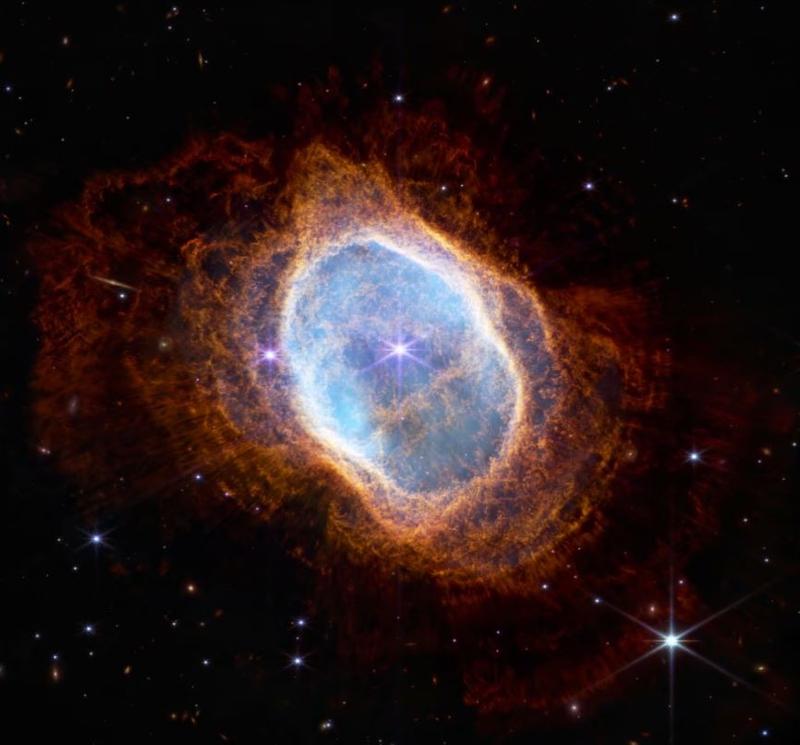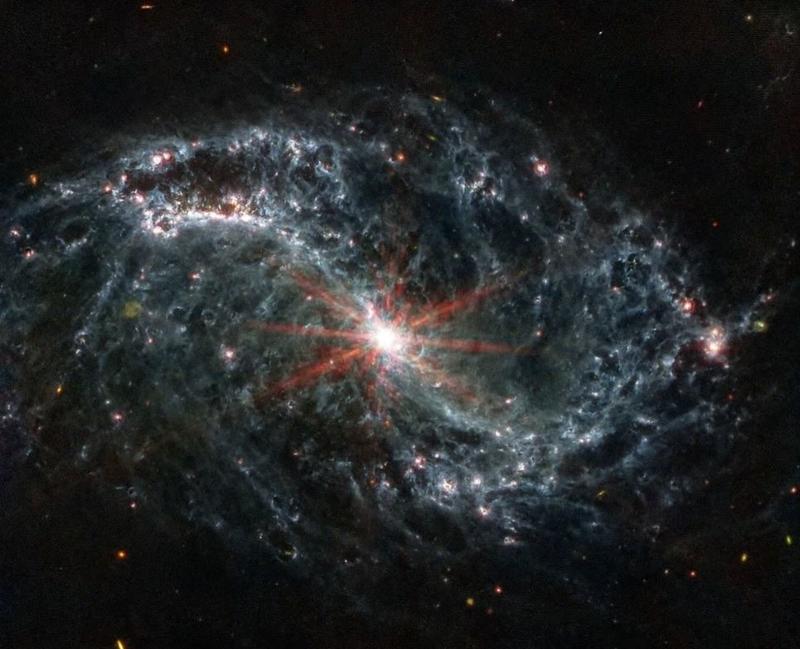 This composite image taken by the James Webb Telescope and released by NASA on Aug 21, 2023 shows a near-infrared image of the Ring Nebula revealing the complexity of its structure in unprecedented detail. Physical features within suggest there may be a companion star helping to sculpt the layers thrown off by the dying star. (PHOTO / NASA / ESA / REUTERS)
This composite image taken by the James Webb Telescope and released by NASA on Aug 21, 2023 shows a near-infrared image of the Ring Nebula revealing the complexity of its structure in unprecedented detail. Physical features within suggest there may be a companion star helping to sculpt the layers thrown off by the dying star. (PHOTO / NASA / ESA / REUTERS)
The James Webb Space Telescope was launched in 2021 and began collecting data in 2022, reshaping our understanding of the early universe while taking wondrous pictures of the cosmos.
 Spiral galaxy NGC 1512, located 30 million light-years away from Earth. Spiral galaxies, resembling enormous pinwheels, are a common galaxy type. Our Milky Way is one. (PHOTO / NASA / ESA / REUTERS)
Spiral galaxy NGC 1512, located 30 million light-years away from Earth. Spiral galaxies, resembling enormous pinwheels, are a common galaxy type. Our Milky Way is one. (PHOTO / NASA / ESA / REUTERS)
 The "Cosmic Cliffs" of the Carina Nebula are seen in an image divided horizontally by an undulating line between a cloudscape forming a nebula along the bottom portion and a comparatively clear upper portion, with data from NASA's James Webb Space Telescope. Speckled across both portions is a starfield, showing innumerable stars of many sizes. (PHOTO / NASA / ESA / REUTERS)
The "Cosmic Cliffs" of the Carina Nebula are seen in an image divided horizontally by an undulating line between a cloudscape forming a nebula along the bottom portion and a comparatively clear upper portion, with data from NASA's James Webb Space Telescope. Speckled across both portions is a starfield, showing innumerable stars of many sizes. (PHOTO / NASA / ESA / REUTERS)
 A nearby planetary system is seen in detail in our first look at an asteroid belt outside our solar system in infrared light. Webb reveals there are actually 3 belts, including 2 never-before-seen inner belts, around the star of Fomalhaut. The 3 nested belts here extend out to 23 billion km from the star, 150 times the distance of Earth from our Sun. (PHOTO / NASA / ESA / REUTERS)
A nearby planetary system is seen in detail in our first look at an asteroid belt outside our solar system in infrared light. Webb reveals there are actually 3 belts, including 2 never-before-seen inner belts, around the star of Fomalhaut. The 3 nested belts here extend out to 23 billion km from the star, 150 times the distance of Earth from our Sun. (PHOTO / NASA / ESA / REUTERS)
 This composite image taken by the James Webb Telescope and released by NASA on Dec 8, 2023 shows the densely packed globular cluster known as NGC 2210, which is situated in the Large Magellanic Cloud (LMC). (PHOTO / NASA / ESA / REUTERS)
This composite image taken by the James Webb Telescope and released by NASA on Dec 8, 2023 shows the densely packed globular cluster known as NGC 2210, which is situated in the Large Magellanic Cloud (LMC). (PHOTO / NASA / ESA / REUTERS)
 This composite image taken by the James Webb Telescope and released by NASA on July 12, 2023 shows a look at Sun-like stars being born in this detailed close-up of Rho Ophiuchi, the closest-star-forming region to Earth. Dark, dense dust cocoons still-forming protostars, while an emerging stellar newborn (top center) shoots out two huge jets of molecular hydrogen. (PHOTO / NASA / ESA / REUTERS)
This composite image taken by the James Webb Telescope and released by NASA on July 12, 2023 shows a look at Sun-like stars being born in this detailed close-up of Rho Ophiuchi, the closest-star-forming region to Earth. Dark, dense dust cocoons still-forming protostars, while an emerging stellar newborn (top center) shoots out two huge jets of molecular hydrogen. (PHOTO / NASA / ESA / REUTERS)
 This composite image taken by the James Webb Telescope and released by NASA on June 26, 2023 shows a part of the Orion Nebula known as the Orion Bar. (PHOTO / NASA / ESA / REUTERS)
This composite image taken by the James Webb Telescope and released by NASA on June 26, 2023 shows a part of the Orion Nebula known as the Orion Bar. (PHOTO / NASA / ESA / REUTERS)
 An observation of a planetary nebula from the NIRCam instrument of NASA's James Webb Space Telescope. (PHOTO / NASA / ESA / REUTERS)
An observation of a planetary nebula from the NIRCam instrument of NASA's James Webb Space Telescope. (PHOTO / NASA / ESA / REUTERS)
 A rarely seen prelude to a Supernova shows a super-bright, massive Wolf-Rayet star in a composite image taken by the James Webb Telescope. The star, WR 124, is 15,000 light-years away in the constellation Sagittarius and is 30 times the mass of our Sun. As the ejected gas moves away from the star and cools, cosmic dust forms and glows in the infrared light detectable by Webb. The Wolf-Rayet phase is a fleeting stage that only some stars go through soon before they explode. (PHOTO / NASA / ESA / REUTERS)
A rarely seen prelude to a Supernova shows a super-bright, massive Wolf-Rayet star in a composite image taken by the James Webb Telescope. The star, WR 124, is 15,000 light-years away in the constellation Sagittarius and is 30 times the mass of our Sun. As the ejected gas moves away from the star and cools, cosmic dust forms and glows in the infrared light detectable by Webb. The Wolf-Rayet phase is a fleeting stage that only some stars go through soon before they explode. (PHOTO / NASA / ESA / REUTERS)
 Complex organic molecules similar to smoke or smog are pictured in a galaxy more than 12 billion light-years from Earth, a new record for the most distant detection of these complicated molecules, in a composite image taken by the James Webb Telescope. (PHOTO / NASA / ESA / REUTERS)
Complex organic molecules similar to smoke or smog are pictured in a galaxy more than 12 billion light-years from Earth, a new record for the most distant detection of these complicated molecules, in a composite image taken by the James Webb Telescope. (PHOTO / NASA / ESA / REUTERS)
 The Crab Nebula, the remains of an exploded star 6,500 light-years away, is seen in a composite image taken by the James Webb Telescope. (PHOTO / NASA / ESA / REUTERS)
The Crab Nebula, the remains of an exploded star 6,500 light-years away, is seen in a composite image taken by the James Webb Telescope. (PHOTO / NASA / ESA / REUTERS)
 Intricate networks of gas and dust featured in the web-like spiral galaxy NGC 7496 are seen in a composite image taken by the James Webb Telescope. Eight red diffraction spikes extend out from its extremely bright core. Colorful dots in the background represent background galaxies. (PHOTO / NASA / ESA / REUTERS)
Intricate networks of gas and dust featured in the web-like spiral galaxy NGC 7496 are seen in a composite image taken by the James Webb Telescope. Eight red diffraction spikes extend out from its extremely bright core. Colorful dots in the background represent background galaxies. (PHOTO / NASA / ESA / REUTERS)
 A group of five galaxies that appear close to each other in the sky: two in the middle, one toward the top, one to the upper left, and one toward the bottom are seen in a mosaic or composite of near and mid-infrared data from NASA's James Webb Space Telescope. (PHOTO / NASA / ESA / REUTERS)
A group of five galaxies that appear close to each other in the sky: two in the middle, one toward the top, one to the upper left, and one toward the bottom are seen in a mosaic or composite of near and mid-infrared data from NASA's James Webb Space Telescope. (PHOTO / NASA / ESA / REUTERS)
 An image of a spiral galaxy like our own Milky Way, known as Messier 74 is seen in a composite image taken by the James Webb Telescope. Shown face-on from our vantage point on Earth, the galaxy's sparkling arms spiral out from a bright white core. Webs of murky dust crisscross the space between the curving silver blue arms, also known as dust lanes. (PHOTO / NASA / ESA / REUTERS)
An image of a spiral galaxy like our own Milky Way, known as Messier 74 is seen in a composite image taken by the James Webb Telescope. Shown face-on from our vantage point on Earth, the galaxy's sparkling arms spiral out from a bright white core. Webs of murky dust crisscross the space between the curving silver blue arms, also known as dust lanes. (PHOTO / NASA / ESA / REUTERS)
 A newborn star only a few tens of thousands of years old, with supersonic jets of gas spewing from its poles, is seen in a composite image taken by the James Webb Telescope. This specific Herbig-Haro object is called Herbig-Haro (HH) 211. At roughly 1,000 light-years away from Earth, HH 211 is one of the youngest and nearest objects of its type. (PHOTO / NASA / ESA / REUTERS)
A newborn star only a few tens of thousands of years old, with supersonic jets of gas spewing from its poles, is seen in a composite image taken by the James Webb Telescope. This specific Herbig-Haro object is called Herbig-Haro (HH) 211. At roughly 1,000 light-years away from Earth, HH 211 is one of the youngest and nearest objects of its type. (PHOTO / NASA / ESA / REUTERS)
 Spiral galaxy NGC 628, located 32 million light-years away from Earth. Webb’s image of NGC 628 shows a densely populated face-on spiral galaxy anchored by its central region, which has a light blue haze that takes up about a quarter of the view. (PHOTO / NASA / ESA / REUTERS)
Spiral galaxy NGC 628, located 32 million light-years away from Earth. Webb’s image of NGC 628 shows a densely populated face-on spiral galaxy anchored by its central region, which has a light blue haze that takes up about a quarter of the view. (PHOTO / NASA / ESA / REUTERS)
 An observation of a planetary nebula from the MIRI instrument in the mid-infrared from NASA's James Webb Space Telescope. (PHOTO / NASA / ESA / REUTERS)
An observation of a planetary nebula from the MIRI instrument in the mid-infrared from NASA's James Webb Space Telescope. (PHOTO / NASA / ESA / REUTERS)
 Columns of gray gas and dust emerge amid The Eagle Nebula, also called M16, and often referred to as the "Pillars of Creation" in a composite image taken by the James Webb Telescope. Backed by dark orange mist, the cloudy gray columns are surrounded by dozens of soft, glowing, pink and purple dots; massive stars emitting enormous amounts of X-rays. (PHOTO / NASA / ESA / REUTERS)
Columns of gray gas and dust emerge amid The Eagle Nebula, also called M16, and often referred to as the "Pillars of Creation" in a composite image taken by the James Webb Telescope. Backed by dark orange mist, the cloudy gray columns are surrounded by dozens of soft, glowing, pink and purple dots; massive stars emitting enormous amounts of X-rays. (PHOTO / NASA / ESA / REUTERS)


